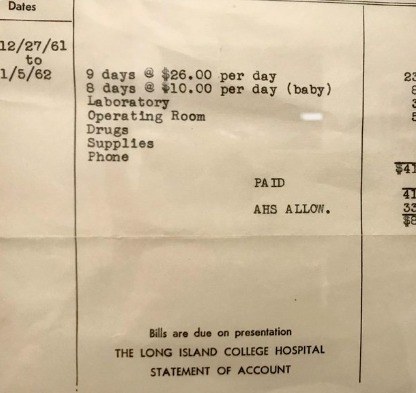Exploring old hospital bills provides a fascinating insight into how healthcare costs have dramatically changed over the years, particularly regarding childbirth. A viral trend has emerged on social media, where people are sharing their parents’ and grandparents’ old hospital bills for childbirth, revealing staggeringly low costs compared to today.
In the 1950s, for instance, a hospital stay after childbirth could cost as little as $10.75, even including services like oxygen and incubator usage. Adjusted for inflation, this would be just over $100 today. Similarly, a 1961 bill for a cesarean section amounted to $80.75 for nine days in the hospital, with the pre-insurance total being $418.85—equivalent to about $3,552.86 today. At that time, even phone fees were itemized, showing a simplicity in billing that’s almost unrecognizable compared to today’s healthcare system.
Fast-forward to the present, and hospital costs for childbirth are astronomically higher. A couple in Utah, for example, was charged $40 simply to hold their newborn after a cesarean section in 2016. These hidden charges have become common, contributing to the unpredictability of modern hospital bills, which often reach tens of thousands of dollars, particularly for more complicated births.
This trend continues when examining hospital bills from as far back as 1947. One person shared a bill for a four-day stay after childbirth totaling $54, which, adjusted for inflation, would be around $634 today. To put that in context, a high-end Bulova watch at the time cost $52.50. In 1936, another family shared their bill of $36 for childbirth, a sum they paid off at a rate of 50 cents a week.
It wasn’t until the 1960s and beyond that hospital bills began to reflect slightly higher costs. By 1968, for instance, a five-day hospital stay for childbirth was billed at $406.80, or $3,015.52 in today’s money. Comparing these prices to current expenses is startling: today’s bills for similar services can easily run into the tens of thousands.
Interestingly, some of these older bills even included quirky items like “hospital barber” services. This reflects how hospitals operated in earlier decades, offering a wide range of services, yet charging a fraction of today’s costs. For instance, a Reddit user shared a bill from their father’s birth in 1955, totaling just $87.65 for a five-day stay—equivalent to $829.81 in today’s dollars.
View this post on Instagram
The most striking contrast comes when comparing these old bills to current figures. A recent commenter shared that their wife’s seven-day hospital stay after childbirth in a U.S. hospital cost a staggering $112,000. This astronomical figure underscores how healthcare inflation has far outpaced normal consumer price increases. Today, medical billing for childbirth often includes a range of services that were either non-existent or much cheaper in previous eras, such as epidurals, neonatal intensive care, and advanced medical technology.
It’s not just inflation that accounts for the steep rise in healthcare costs. Over the past several decades, the healthcare industry has undergone significant transformations, particularly in terms of technological advancements, insurance industry practices, and hospital administration. The increasing complexity of medical procedures, the development of new drugs, and the prevalence of medical insurance have all contributed to higher costs. Additionally, hospitals and insurance companies have often been criticized for their lack of transparency, making it hard for expectant parents to predict what they might owe.
Moreover, the expansion of for-profit healthcare systems in many parts of the world, especially the U.S., has driven prices up. The administrative costs associated with insurance, as well as the substantial profits of pharmaceutical and medical device companies, also add to the overall expense. In contrast, many countries with universal healthcare systems manage to keep costs for childbirth much lower than those in the U.S., often covering most or all expenses for expectant parents.
Yet, even as costs have increased, many people find themselves reflecting on whether the improvements in medical care are always worth the extra price. While modern medicine undoubtedly saves lives, particularly in complicated pregnancies and births, the simplicity and affordability of past healthcare systems remain attractive to those facing daunting medical bills today.
Ultimately, the rise in the cost of childbirth reflects broader economic and social trends, including the increasing financialization of healthcare and the growing gap between wages and healthcare costs. For expectant parents today, the high price of childbirth can be a significant financial burden. But looking back at these historical bills shows that there was once a time when having a baby was far more affordable.
As families continue to share these historical hospital bills, it serves as a poignant reminder of how much things have changed. It raises important questions about the future of healthcare costs and whether today’s system, with its frequent hidden fees and sky-high prices, is sustainable.
In conclusion, these old hospital bills not only reflect the drastic inflation in healthcare costs over the past several decades but also serve as a glimpse into a time when starting a family didn’t come with such a hefty price tag. While medical technology and standards of care have certainly advanced, many are left wondering whether today’s prices truly reflect the value received, or if there are ways to make healthcare, particularly childbirth, more affordable once again.

